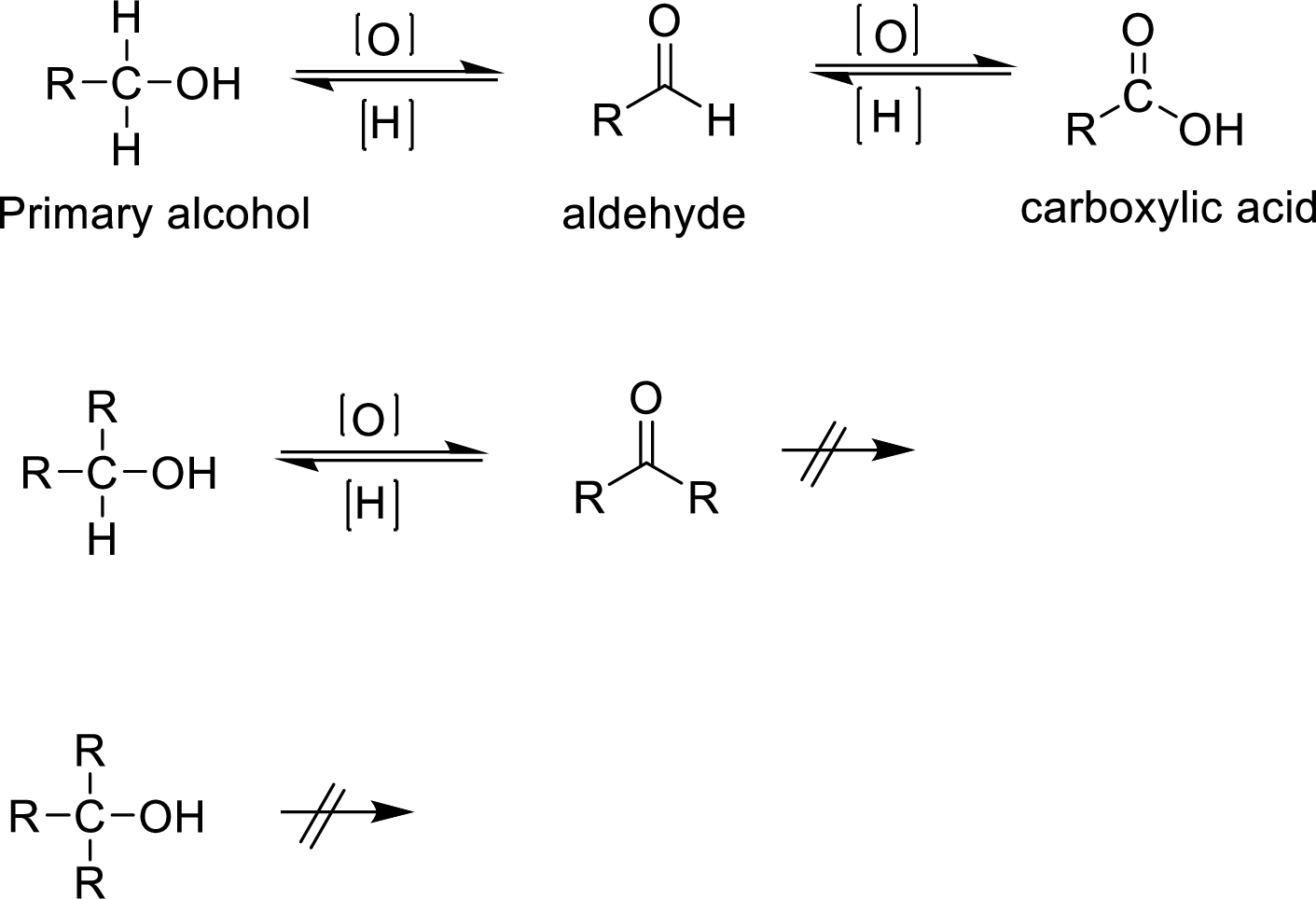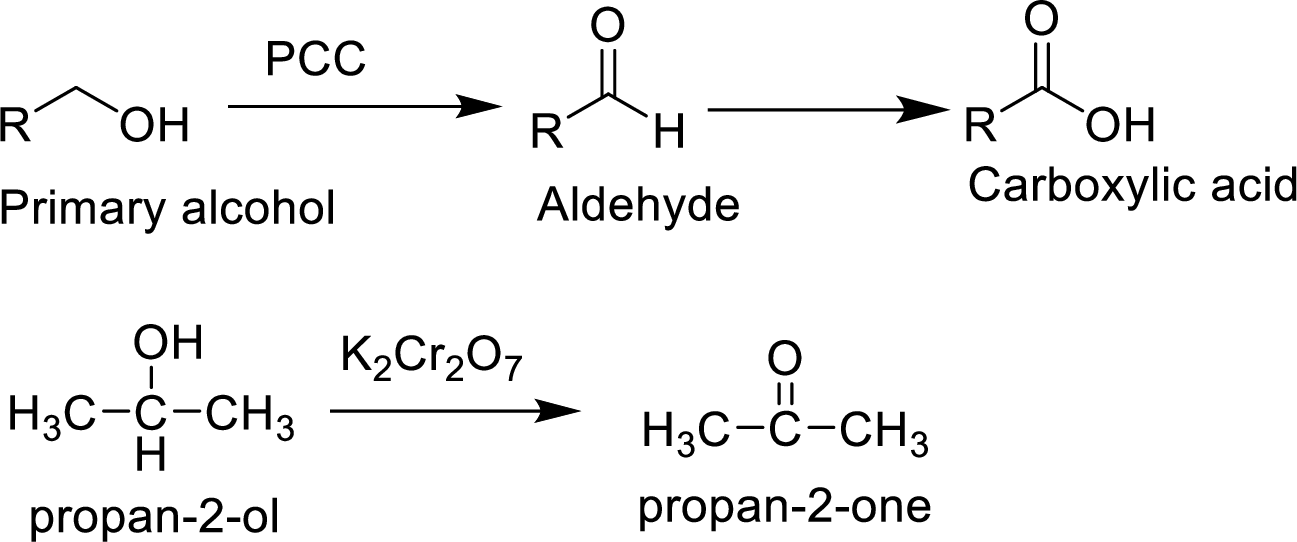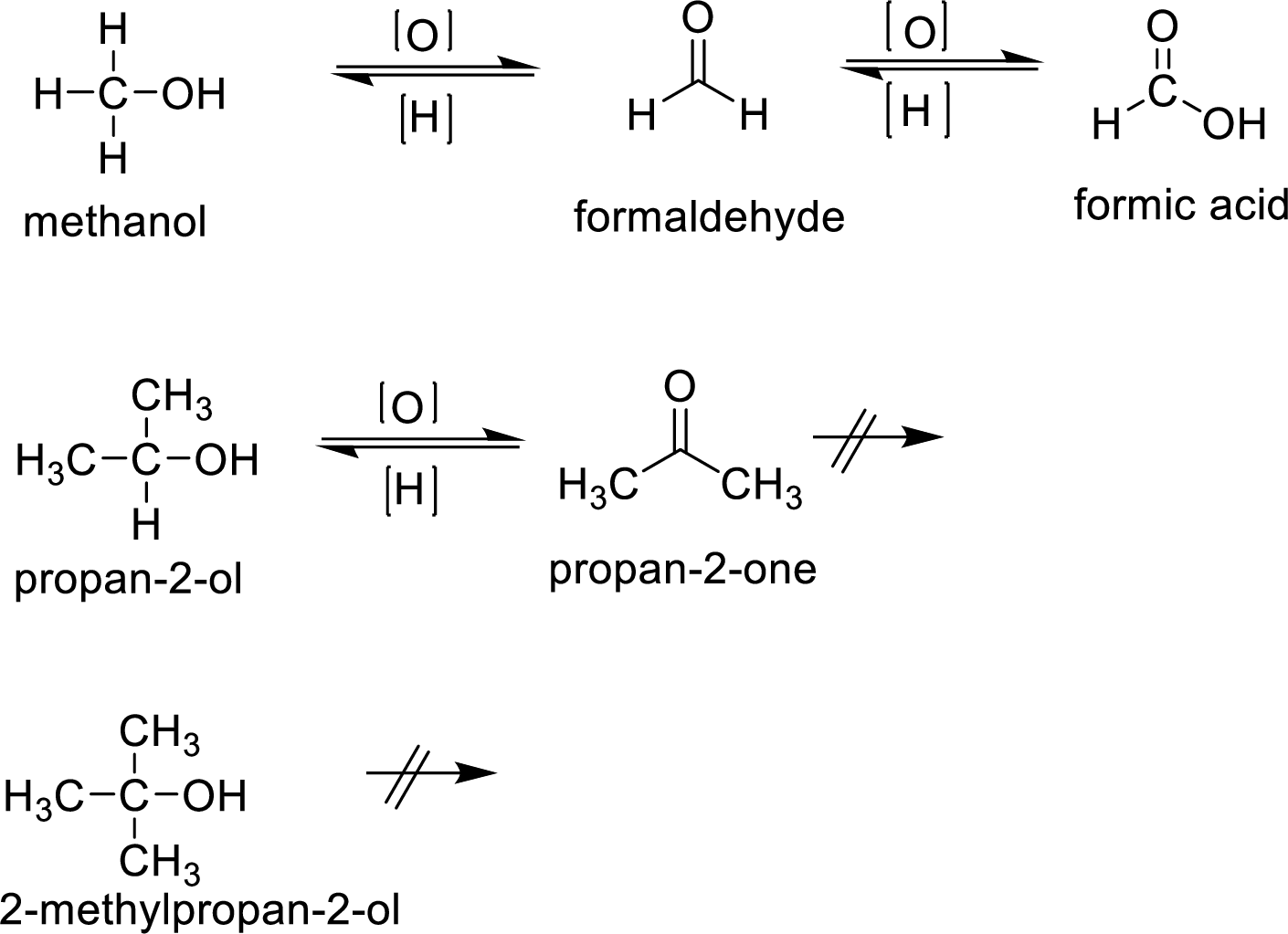
(a)
Interpretation:
Structural formula of a compound with the given formula upon oxidation by potassium dichromate in aqueous sulphuric acid gives
Concept-Introduction:
Oxidation:
Loss of electrons from an atom ion or molecule during a
Example:

Here
Oxidation of alcohols:
Oxidation of alcohol gives

(b)
Interpretation:
Structural formula of a compound with the given formula upon oxidation by potassium dichromate in aqueous sulphuric acid gives carboxylic acid has to be drawn.
Concept-Introduction:
Oxidation:
Loss of electrons or loss of hydrogen from an atom ion or molecule during a chemical reaction is known as oxidation. Oxidation state of atom ion or molecule will increase in this process. In simple it is the gain of oxygen.
Example:

Here
Oxidation of alcohols:
Oxidation of alcohol gives aldehydes ketones carboxylic acid Primary alcohols on oxidation yield carboxylic acid. Secondary alcohol on oxidation gives ketone. If mild oxidizing agents are used the the reaction will end with an aldehydic product. In the formation of carboxylic acid the alcohol is first oxidized to aldehyde which is then oxidized to form carboxylic acid. Oxidation is not possible in tertiary alcohol because there is no reactive

(c)
Interpretation:
Structural formula of a compound with the given formula upon oxidation by potassium dichromate in aqueous sulphuric acid gives carboxylic acid has to be drawn.
Concept-Introduction:
Oxidation:
Loss of electrons from an atom ion or molecule during a chemical reaction is known as oxidation. Oxidation state of atom ion or molecule will increase in this process. Oxidizing agent is getting reduced in oxidation. In simple it is the addition of oxygen or removal of hydrogen.
Example:

Here
Oxidation of alcohols:
Oxidation of alcohol gives aldehydes ketones carboxylic acid Primary alcohols on oxidation yield carboxylic acid. Secondary alcohol on oxidation gives ketone. In the formation of carboxylic acid the alcohol is first oxidized to aldehyde which is then oxidized to form carboxylic acid. Oxidation is not possible in tertiary alcohol because there is no reactive

Trending nowThis is a popular solution!

Chapter 17 Solutions
Student Study Guide and Solutions Manual for Brown/Iverson/Anslyn/Foote's Organic Chemistry, 8th Edition
- Calculate the pH and the pOH of each of the following solutions at 25 °C for which the substances ionize completely: (a) 0.000259 M HClO4arrow_forwardWhat is the pH of a 1.0 L buffer made with 0.300 mol of HF (Ka = 6.8 × 10⁻⁴) and 0.200 mol of NaF to which 0.160 mol of NaOH were added?arrow_forwardDetermine if the following salt is neutral, acidic or basic. If acidic or basic, write the appropriate equilibrium equation for the acid or base that exists when the salt is dissolved in aqueous solution. If neutral, simply write only NR. Be sure to include the proper phases for all species within the reaction. NaN₃arrow_forward
- A. Draw the structure of each of the following alcohols. Then draw and name the product you would expect to produce by the oxidation of each. a. 4-Methyl-2-heptanol b. 3,4-Dimethyl-1-pentanol c. 4-Ethyl-2-heptanol d. 5,7-Dichloro-3-heptanolarrow_forwardWhat is the pH of a 1.0 L buffer made with 0.300 mol of HF (Ka = 6.8 × 10⁻⁴) and 0.200 mol of NaF to which 0.160 mol of NaOH were added?arrow_forwardCan I please get help with this.arrow_forward
- Determine if the following salt is neutral, acidic or basic. If acidic or basic, write the appropriate equilibrium equation for the acid or base that exists when the salt is dissolved in aqueous solution. If neutral, simply write only NR. Be sure to include the proper phases for all species within the reaction. N₂H₅ClO₄arrow_forwardPlease help me with identifying these.arrow_forwardCan I please get help with this?arrow_forward
 World of Chemistry, 3rd editionChemistryISBN:9781133109655Author:Steven S. Zumdahl, Susan L. Zumdahl, Donald J. DeCostePublisher:Brooks / Cole / Cengage Learning
World of Chemistry, 3rd editionChemistryISBN:9781133109655Author:Steven S. Zumdahl, Susan L. Zumdahl, Donald J. DeCostePublisher:Brooks / Cole / Cengage Learning Chemistry for Today: General, Organic, and Bioche...ChemistryISBN:9781305960060Author:Spencer L. Seager, Michael R. Slabaugh, Maren S. HansenPublisher:Cengage LearningChemistry: Matter and ChangeChemistryISBN:9780078746376Author:Dinah Zike, Laurel Dingrando, Nicholas Hainen, Cheryl WistromPublisher:Glencoe/McGraw-Hill School Pub Co
Chemistry for Today: General, Organic, and Bioche...ChemistryISBN:9781305960060Author:Spencer L. Seager, Michael R. Slabaugh, Maren S. HansenPublisher:Cengage LearningChemistry: Matter and ChangeChemistryISBN:9780078746376Author:Dinah Zike, Laurel Dingrando, Nicholas Hainen, Cheryl WistromPublisher:Glencoe/McGraw-Hill School Pub Co Chemistry: Principles and ReactionsChemistryISBN:9781305079373Author:William L. Masterton, Cecile N. HurleyPublisher:Cengage Learning
Chemistry: Principles and ReactionsChemistryISBN:9781305079373Author:William L. Masterton, Cecile N. HurleyPublisher:Cengage Learning Organic And Biological ChemistryChemistryISBN:9781305081079Author:STOKER, H. Stephen (howard Stephen)Publisher:Cengage Learning,
Organic And Biological ChemistryChemistryISBN:9781305081079Author:STOKER, H. Stephen (howard Stephen)Publisher:Cengage Learning, General, Organic, and Biological ChemistryChemistryISBN:9781285853918Author:H. Stephen StokerPublisher:Cengage Learning
General, Organic, and Biological ChemistryChemistryISBN:9781285853918Author:H. Stephen StokerPublisher:Cengage Learning





